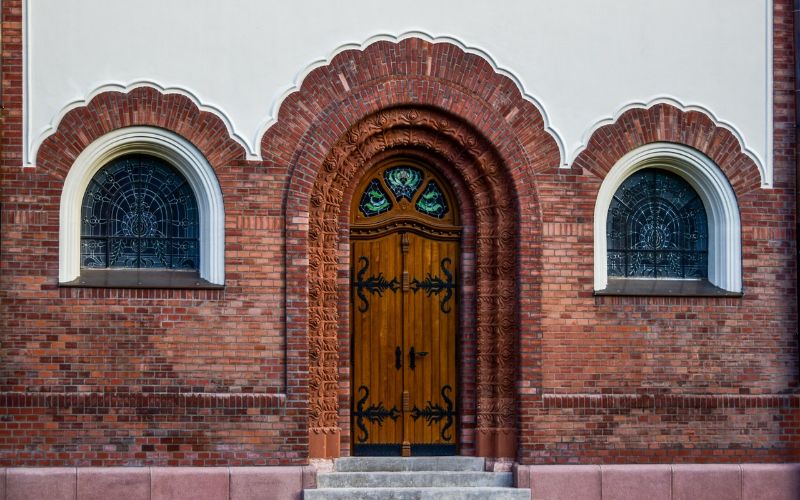All brick house owners usually experience a quandary on what color to paint their doors. If you paint your door with any color without putting in some thought, you may end up not liking the final outlook.
This article will give you the best red brick house front door color ideas for your home. I’ll accompany the views with a few picture insets to guide your pickings and choices; Seeing is believing, to coin a phrase.
You can paint your front door blue, white, orange, red, green, yellow, pink, black, or purple. There are several shades of the colors I’ve just mentioned!
You can play around with these shades to give your brick house front door the best curb appeal. Colors affect our perceptions and moods, but different geographical regions and cultures perceive the same colors differently.
The color you choose depends on your geographical location, cultural ethos, personal preference, personality, occupation, age, and a host of other factors. I’ve drawn the ideas I’m about to share from basic color theory and visual arts.
Would you like to pick a color for your front door without straying? A color that won’t look awkward for your house, environment, or neighbors? Then I urge you to read this till the very end.
Front Door Colors that Match a Red Brick House
There are two main color categories that go with red brick houses, i.e., warm colors and cool colors.
The feasibility of color between the red house and its front door is also contingent on cultural beliefs, the intensity/shade of red used, individual’s taste, regional connotations of colors, etc.
If you go by the factors I’ve mentioned above, you’ll realize that countless door colors will match a red brick house. You need to equilibrate all these factors to end up with the best color for the said door.
To illustrate, painting your front door black elicits elegance and power in some regions. The same color evokes sadness and evil-mindedness.
To some people, black implies seriousness, while it’s associated with rebellion to others. Mind you, this is a single color we’re talking about; the dynamics shift many times over when we run the gamut of colors.
That’s why I emphasize the need to weigh all factors to come up with the right balance. When the positive attributes of one paint color outweigh the negatives in a given region, it’s safe, or rather, appropriate to use it.
If you find the negatives overwhelming the positives, consider using a different one; the colors abound, after all.
That said, I’ll front the best door colors for varying situations together with their adverse effects in the subsequent texts. Read intently.
Best Warm Front Door Colors For a Red Brick house
Warm colors evoke a feeling of relaxation, comfort, and coziness. The door is among the first things a visitor sees when they come to your house.
Warm colors make visiting friends or colleagues feel welcomed and belonging. Here are some of those colors:
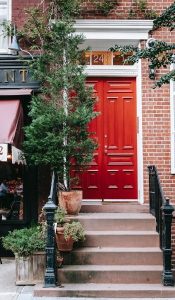 Red
Red
Red, especially the light shade, connotes love and friendship in many countries. It makes people feel warm, cozy, and safe in the surrounding environment.
Additionally, the red color will match the red bricks of the walls, giving your home a uniform color shade.
The adverse effects of red include aggression, danger, fire, and absolute dominance.
Burnt Orange
The above is a darker shade of orange named in the first quarter of the 20th century. This color brings an element of togetherness, kindness, and affability. All of the mentioned attributes are the elements of a cozy atmosphere.
When you juxtapose burnt orange with red, they form a fitting pair that improves your abode’s overall appearance.
I urge you to try out the above color, and you’ll love every bit of your results.
The color’s negative side includes insincerity, impatience, deceitfulness, frustration, and frivolity.
Yellow
Generally, yellow and most of its shades flank the color wheel on its warm side; however, there are few cool variants. Most warm yellows have orange undertones; orange is the underlying color bias for yellow.
A soft, complementary contrast emerges when you partner a red brick house with a yellow door to give a welcoming glow.
The antipathetic nature of yellow is fear, cowardice, betrayal, and irritability.
Pink
As I’ve already mentioned, warm colors signify coziness or comfort. Most shades of pink are warm. It’s because pink is a tint of red, which itself is a warm color.
Warm pink shades include shocking pink, bright magenta, and bright Fuschia. When you paint your door with any of the just-mentioned pink shades, it will link well with the red brick walls to give you a homely/temperate experience.
The color’s negative connotations are childishness, timidity, weakness, and inexperience.
Best Cool Front Door Colors For a Red Brick House
The expression “cool color” describes a soothing effect in nature.
These are the colors of water, night, nature, etc. They are reserved and relaxing. They don’t overwhelm and have the disposition to recede in space; the receding property makes its surroundings look larger.
Examples of cool colors for front doors are:
Blue
Most shades of blue bring about an aura of coolness. For example, navy blue, which is one of the colors of large water volumes, is a cool color. It brings about a feeling of serenity, peace, and tranquility.
Royal blue brings about a feeling of security, compassion, and sincerity.
Tiffany blue translates to luxury, glamor, and excitement.
All of the above are the trappings of a cool head and emotions.
Paint your brick house door with one of these blue shades to contrive a cool ambiance.
The negative implications of the color in question are fragility, conservativeness, coldness, and unfriendliness.
Cyan
Cyan is a continuum of colors between blue and green. Colors in this range include turquoise, aquamarine, teal, electric blue, and other blue-green colors.
Since both blue and green are independently cool colors, combining them will, unsurprisingly, result in a cool color.
You can find all of the above colors in large water bodies, and they elicit a feeling of freshness, deep connection to nature, meditation, and bliss. You are likely to get similar feelings if you paint your brick house door with the said colors.
The negatives of cyan include emotional detachment, selfishness, deception, and unreliability.
Green
The green color and some of its shades are cool colors that bring about feelings of freshness, an abundance of life, and safety.
For illustration, when you see green vegetables, the first thing that crosses your mind is that they are fresh. When you see vegetation, it shows they are alive and healthy.
When you see green like in traffic lights, it implies it’s safe to go; there’s even an expression that says “give the green light!” which means it’s safe to do something. Green is also the color of nature (trees and other vegetation).
Therefore, when you paint your red brick house green, all or most of the above message passes across clearly.
The red and green pairing gels quite well and works like a dynamic duo, with red contributing warmth, love, and even life (like blood) to the mix.
The negating implications of green are envy, judgemental, materialism, greed, and a lack of knowledge/understanding.
Purple
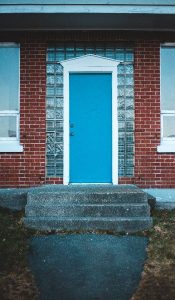 Purple is another cool color, but it’s close to the borderline between cool and warm. Being close to the frontier with warm colors, part of its brighter shade is warm, while the more significant portion toward the darker side of the spectrum is cool.
Purple is another cool color, but it’s close to the borderline between cool and warm. Being close to the frontier with warm colors, part of its brighter shade is warm, while the more significant portion toward the darker side of the spectrum is cool.
The double-faceted trait of purple on the color wheel is because it’s a mixture of red and blue, but more blue.
Mindful of the above, painting your red brick house door purple gives it a cool character and a tad of warm traits.
The offsetting effects of this color are arrogance, immaturity, frustration, and sadness.
Violet
Violet and purple almost look similar, and some people even use them interchangeably. The difference in their optics is that violet is lighter than purple.
Beyond the optics, the two colors are totally different; violet is a pure color, while purple is a combination of colors, i.e., red and blue.
Focusing on violet, its lightest quarter close to red is regarded as warm; the remaining darker fraction edging towards blue is cool. Therefore, we consider violet a cool color on an overall scale.
Painting your brick house’s front door violet gives the effect of motivation, balance, and inspiration. What a great way to welcome your friends, colleagues, and even potential purchasers!
The dispirited perceptivity of violet is indifference, cynicism, immaturity, and arrogance.
Best Neutral Front Door Colors For Red Brick House
By definition, neutral colors are those that don’t have a color or have trace amounts of hue.
The colors, though visible, do not stand out because they are ordinary, and people are accustomed to their presence. These colors elicit muted feedback from people and are less likely to draw attention.
When we see neutral colors on doors, we will likely forget the exact color after a few hours! Well, that’s the sole purpose of these colors, and some homeowners like it that way.
The most common neutral colors are black, white, brown, and gray. Other less commonly known ones are beige, tan, and taupe.
On the upside, people love the above colors because they look modest, executive, and formal. Plus, there is little room to color-clash; the colors match just about every other color.
One little fact about neutral colors is that they are absent on the color wheel.
Take a look at the details below showing how individual neutral colors suit front doors for brick houses:
Black
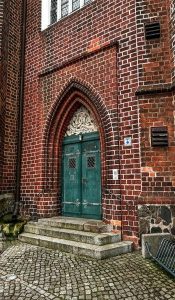 Black is the quintessential neutral. What could ever go wrong with painting a front door black? Absolutely nothing. If you’re apprehensive about mismatching the red brick house with another color, this is the go-to color.
Black is the quintessential neutral. What could ever go wrong with painting a front door black? Absolutely nothing. If you’re apprehensive about mismatching the red brick house with another color, this is the go-to color.
In its neutral capacity, black gives the impression of elegance, power, sophistication, mystery, and solemnity/seriousness.
Black is the strongest of the neutral colors, and it works not only for doors of red brick houses but also for other colors and building materials.
The contemptible perceptions of black are evil, pessimism, fear, death, and war. The negative perceptions of black are particularly powerful.
White
This perhaps comes as a surprise! White is a neutral color, as bright as it looks. Like black, it’s congenial to most colors, including red brick houses.
Its ability to match every other color gives you room to paint your door without worrying about color discordance.
The white symbolizes innocence, purity, virtue, cleanliness, and peace.
We clearly deduce from the above attributes that white sends powerful positive impressions almost unmatched by other colors. Its messages are so powerful that there are only a few negative impressions of the color in question.
The few negative connotations are also relatively innocuous.
The few negatives of white are emptiness, blandness, boredom, and isolation.
Brown
Brown is deeply embedded in the neutral wing of the color edifice. So much so that almost all its shades are neutral. The color has the appearance of bare soil/barren land and dry wood. These are sightings that imply neutrality in some parts of the world.
The color in question and its shades have neutral traits that relax, stabilize, improve appetite, and bring comfort. It’s also easily relatable to nature as the terrestrial earth has the same color.
I urge you to paint your doors with this color so that you can experience the effects I’ve described above.
The distasteful properties of brown include dullness, boredom, conservativeness, and naivety.
Gray
Gray is the result of combining white with black. The proportion of each color in the mixture influences the final shade of gray; excuse the pun.
As a neutral color, gray has the positive effects of liberalism, wisdom, tranquility, and intellect.
This timeless color often looks sleek on whatever surface it covers. The black and white mix also has a semblance of diplomacy.
It is the perfect color if you want a door that’s neither reflective nor absorptive for light.
The deplorable characteristics of the color above are indecisiveness, decay, indifference, and lack of confidence.
Beige
Beige is a neutral color that always shows neatness and cleanliness. It blends in seamlessly with other colors to give a conventional appeal.
Its positive effects are friendliness, order, calmness, and flexibility. These qualities will give your red brick house a unique yet subtle curb appeal.
The negating attributes of the color in question are depression, stagnation, blandness, and lethargy.
Tan
The above is a pale shade of brown. It derives the name from tannum (oak bark) used in tanning leather. Its lightness has led some texts and experts to label it a warm neutral. The tan is a perfect complement, especially for an intense red brick house.
The positive effects of tan are elegance, dominance, sophistication, and power. It brings about these effects in a calm, quiet, and less expressive manner than warm colors.
The disreputable traits of this color are dullness, timidity, loneliness, and old.
Best Door Colors for Different Shades of Red Houses
Numerous tones of red have been identified in the contemporary world. Each of these shades forms a unique ensemble when used alongside other colors.
Therefore, the tint of red is an essential point to look into when choosing a front door color. This section will mention the most common tones of red bricks and the door colors that match them.
Varieties of red color differ in lightness (value, tone, or brightness), hue, or chroma (intensity, colorfulness, or saturation). They can also vary in two or all three of the above aspects.
I’ll use the standard RGB system to describe the red hues because that’s what the computer screens use; the actual/physical colors use the CMYK system (pigment red) to project the red color.
Bricks differ in red hues depending on the firing temperature during processing and the chemical constituents (iron content). Moreover, some homeowners and painters apply red paint to bricks to change the tint.
According to many design experts, the most complimentary colors stand opposite each other on the color wheel. They don’t have to be precise opposites; being far apart is good enough.
These are the most prevalent red brick shades and the matching door colors:
Crimson
Crimson is an intense, deep, bright red color leaning toward purple. The purple inclination is due to its combination with some violet and blue.
It’s also the color obtained when rose and red overlap on the RGB color wheel or when red and magenta overlap on the RYB color wheel.
If the bricks are crimson, the matching colors for the door are royal blue, burgundy, and olive. Neutrally-colored doors like white or brown also combine well with crimson bricks.
Scarlet
This is a bright red mixed with a faintly orange tinge. It’s the color worn by cardinals in the Roman Catholic Church.
This color results from blending 14% green, 100% red, and 0% blue on the RGB color scheme; for the CMYK color scheme, you obtain scarlet by combining 100% yellow, 86% magenta, 0% cyan, and 0% black.
A scarlet red is a very strong/dominant color, so it’s not congruous with most of the other dominant colors; doors with neutral colors like sandy brown or warm colors like beige make a perfect match for scarlet bricks.
Other complementary colors for scarlet include dark blue and most shades of gray.
I recommend that you avoid pairing scarlet red with pastel tones like lime, peach, and coral, as they will clash.
Cardinal Red
This vivid red color derives its name from cassocks/soutanes put on by Catholic cardinals. The name is a misnomer because the actual red shade of soutanes is scarlet.
The best door complement to the above color is light sea green, otherwise known as cyan. This color combination produces an excellent contrast that oozes elegance and gets everybody’s attention.
Other exterior door colors that pair up with cardinal red include Persian blue and harlequin green.
You can choose the one you like from the above; the final decision rests with you.
Rusty Red
This is a metallic color that Crayola contrived in 1990. This color is a family of red with high saturation and medium brightness. Its corresponding RGB values are 75, 28, and 40; it contains 52% red, 20% green, and 28% blue.
Numerous door colors go in harmony with a rusty red brick house. The colors are:
Brunswick green: This is the complementary color that is located roughly opposite rusty red on the color wheel.
Russet brown and American purple: These are the analogous color palettes to rusty red. The two colors are located 30° on either side of rusty red on the RGB color wheel. These colors look stunning on front doors, and I rank them among the best.
Pantone Green and Japanese Indigo/Dark Cyan: These are what we call split-complementary colors for rusty red. Split-complementary colors were rarely used in the past, but there has been a recent upsurge in their use.
It’s probably because they do not produce as sharp a contrast as complementary colors. You can try out one of these two to better understand what I’m communicating.
Army green and Russian violet: Army green is an olive drab color, while Russian violet is a dark tone of blue-magenta. The two colors go hand in hand with rusty red bricks, with the olive drab representing sophistication and the Russian violet manifesting mystery and royalty.
Vermilion
Vermilion is an orangish-red pigment originally obtained from powdered cinnabarite, the bright red form of mercury (II) sulfide. This color is slightly brighter than cochineal red.
The term vermilion is still widely used to describe red shades, but it’s no longer sourced from mercury (II) sulfide. It is because mercury is poisonous to humans.
Vermilion-colored bricks go well with the following front door colors:
Pacific blue: This is its complementary color. This kind of blue shows intelligence and creativity.
Rose-red and Cadmium red: These are the analogous palettes to vermilion red. Red colors have remained timeless in communicating affection, tenderness, and adoration.
Cerulean blue and green-cyan: These are the split-complementary colors to vermilion red.
All of the above door colors gel pretty well with the red brick shade in question. The one you pick is a matter of personal preference and other factors.
Blood Red
Blood red color describes a dark shade of red. Generally, blood is always red, but in specific terms, it has different shades of red ranging from bright and dark to brownish.
The color that I’ll focus on here is dark red since that’s the one we see when someone sustains a cut or a superficial injury. It’s because this blood is from veins, and it is deficient in oxygen.
Blood red contains red with no blue or green components in the RGB color system.
Blood red brick walls are compatible with the following front door colors:
Celadon green: This light-blue green tone is named after a given kind of ceramic in China. The color has tinges of jade and gray in its hue, and it gives an impression of freshness, vitality, and wholesomeness. It is a complementary color to blood red.
Russet color & Pansy purple: Russet is dark brown with a reddish-orange tint. As a tertiary color, it’s a mix of purple and orange pigments in identical proportions. Pansy purple is a moderately-dark tone of magenta pink. The two door colors work in tandem with blood-red bricks as they are its analogous palettes.
Salem & Metallic blue: Salem belongs to the green family, and it consists of cyan and green in equal proportions. Metallic blue is a moderately-dark hue of cyan-blue. They are the split-complementary palettes for blood red.
Both colors result in remarkably beautiful front doors for a blood-red brick house.
Carmine
Carmine color is also referred to as imperial red; it describes deep red hues with purple fills. The first cited use of carmine to describe a red hue in English was in the 16th century.
Raw, unprocessed carmine pigments are a deep and dark red, while the processed versions are lighter.
Carmine has long wavelengths greater than 600 nm; this means it is close to the extreme end of red shades.
The RGB color model on computer screens cannot illustrate it accurately; the one you see physically is the most valid in terms of precision.
Carmine-colored bricks are harmonious with the following front door colors:
Jungle green: this is a rich hue of medium spring green; it is associated with the green of tropical rainforests. It is a complementary color to carmine red.
Golden brown & Bright amaranth pink: These are the analogous palettes to carmine. Golden brown gets its name from the color of gold, while bright amaranth gets its name from the color of amaranth flowers.
Sea green: This is the split-complementary palette to carmine red. The juxtaposition of this color with red brings about appeasement, inspiration, relaxation, and hope.
All of the above are the most appropriate front door colors for carmine brick houses.
Other Things to Consider When Choosing Front Door Colors For Red Brick House
As I’d intimated earlier, choosing a front door color isn’t a straightforward task that can be done without careful thought. It requires some analysis to make the project successful.
There are more factors to consider (excluding the ones I’ve already mentioned) for this undertaking. I’ll discuss some of these considerations in this section.
The other factors include the roof color, the surrounding environment, and the size of the door. Compared to the early mentions, these are subordinate factors, but they are still important. Let’s go ahead and look at their roles.
Roof color
The curb appeal of most houses focuses on the roof, walls, and front doors. The roof takes up around 40% of what people see outside the home.
It’s therefore essential to ensure all the three are in harmony regarding their colors. I’ll proceed to mention a few roof colors and their matching front door color.
Dark-Gray Roof
Many homeowners use dark-gray colors to crown their houses. The color gives your house excellent curb appeal, and the roofs are mostly made of iron sheets. The best front door colors for a dark-gray roof are blue, red, white, and black.
You can use different shades of the colors I’ve mentioned above depending on the shade of red bricks and personal taste. To aid in your selection, look at pictorial illustrations of the roof-front door color combinations before you choose.
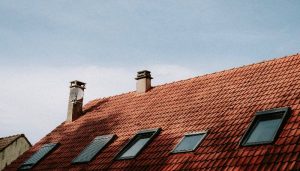 Red Roof
Red Roof
A red roof looks excellent any day and is easy to spot from afar. Red painted roofs elicit positive feedback whether the material is the iron sheet, tiles, asphalt shingles, steel, or aluminum.
The front door hues suitable for red roofs include white, green, tawny-orange, black, brown, and blue. Again, you can choose a harmonious shade for the existing red brick shade.
Brown Roof
Brown is a neutral color that looks subdued but classy. It makes the house blend in with the surrounding environment and evokes a strong connection with nature. As with the other roof types, there are several materials that you can use to make a brown roof.
The most appropriate front door colors for brown roofs are turquoise, orange, fuchsia, blue, mint, white, and yellow. Most of the colors are warm and bright to make the house noticeable.
Green Roof
Green is a cool color popular in terms of liking and usability among homeowners. Many people use it on their roofs to make them look picturesque, camouflage into the surrounding green environment (vegetation), and bring about the feeling of eco-friendliness.
Front door colors that go with a green roof are neutrals like gray and brown, bright yellow, blue, light orange, and emerald. The colors supplement the green roof in ways that depict a happy and prosperous household.
Blue Roof
According to some reliable texts, blue is the favorite color for most of the world’s population. The color conjures up feelings of good health, serenity, and order. It’s no surprise, therefore, that its use on roofs abounds.
The best front door colors that match blue roofs are peach, red, black, white, orange, and cream. Blue is always in accord with almost all colors.
You have the liberty to pick the color combination that you find most impressive.
How the Surrounding Environment Influences Your Door Color
Your immediate surrounding also impacts the front door color. It seems far-fetched but takes a look at these situations:
If you buy a house in a cookie-cutter neighborhood, would you have your front door painted differently from other houses? Most likely, no!
Another instance is when you are in an environment where people intolerably associate certain colors with negative or even ominous consequences.
Those are some examples where the surrounding environment will influence the color choice of your door. That’s why I emphasize you do some research and think ahead of painting.
How Door Size Determines Its Color
Again, these are rather subordinate influences on front door color choice; don’t prioritize them as much as the points I mentioned earlier when choosing a front door color. So how does the door size influence your color choice?
The larger the front door, the more visible it is and vice versa. So if you have a large front door and don’t want it to be the center of attention for observers, you can paint it with neutral or dull colors.
Conversely, if you have a small front door and you want it to be clearly visible, I urge you to paint it using brighter colors.
Conclusion
To conclude, colors play a critical role in design; they can make or break an entire project. We’ve seen how differently one color can be perceived in various settings and the consequences of ignoring these differences. I’ve focused this article on…
Red Brick House Front Door Color
Another point worth taking home is that there is no wrong color for this project! It’s more of whether the color you’ve settled for fits into the prevailing circumstances.
The circumstances include acceptability to the surrounding society, personal preference, regional views, feasibility between the door color and the red brick wall, and many other factors.
The different societal perceptions of a given color are not always direct opposites. Sometimes, it elicits two or more different positive feedbacks or two different negative responses.
For instance, blue could mean loyalty and trustworthiness in one cohort, but it could also translate to mental acuity, sharpness, and creativity in another context.
The same color is sacred to some, probably because they’re surrounded by blue sea waters where they believe deities or spiritual beings dwell. Yet to others, this one color means life.
Another factor that I’ve detailed is that the red of your brick house might be different from the red of your neighbor’s brick house and other houses. It’s because there are different shades of red.
The colloquial name for all shades of red is just red; only the experts are good at the specifics like scarlet, crimson, claret, carmine, terracotta-red, rust-red, wine-red garnet, etc.
In the public domain, most people refer to them as red; the most detailed an average joe can go is dark red/deep red or light red to describe the different shades.
I’ve mentioned all these to let you know that the shade of your red brick house really matters when you’re planning on what color to paint your door.
If someone tells you that their red brick house is in perfect accord with their blue door, ensure the red they are talking about is the same as your red brick house before painting your door blue.
The red they are talking about could be barn red, while yours could be vermilion red, so just confirm before you take steps.
I’ve also highlighted other elements that will help you navigate to the right color choice; they include the roof color, the size of your door, and the surrounding environment.
After all of the above, I wish you all the best as you adorn your red brick house with the right color on its front door.
